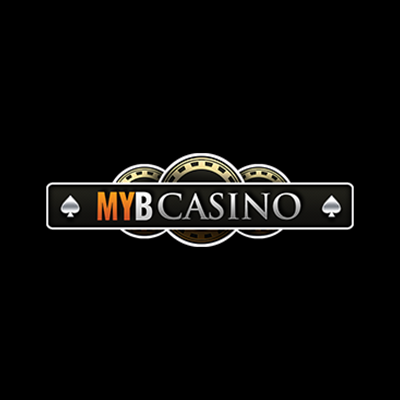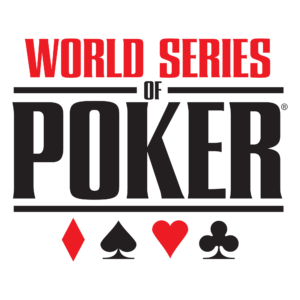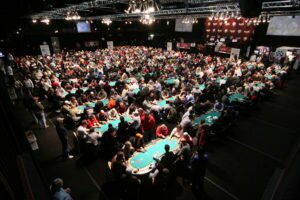What began in 1970 has come quite a long way in Las Vegas. The WSOP originated at the Binion’s Horseshoe Casino in Downtown Las Vegas. Beginning with 2005, it has since made its way over to the Rio, currently owned by Caesars Entertainment.
Top Rated US Casino Sites
| Casino | Bonus | Play | Review | Games | Deposit | Device | Rating | |
|---|---|---|---|---|---|---|---|---|
| 1 |  |
Up to USD5,000 Welcome Bonus | Visit Casino | Read Review | Slots, Table Games, Bingo, Poker 24/7 | Visa, Mastercard, Bitcoin, Neosurf | Mobile, Desktop | 90 |
| 2 |  |
Free (No deposit required) | Visit Casino | Read Review | Slots, Table Games, Mobile Compatible | Visa, Mastercard, Bitcoin, Neosurf | Mobile, Desktop | 100 |
| 3 |  |
280% Welcome Offer | Visit Casino | Read Review | Slots, Table Games, Mobile Compatible | Visa, Mastercard, Bitcoin, Neosurf | Mobile, Desktop | 80 |
| 4 |  |
250% Deposit Match + 50 Free Spins | Visit Casino | Read Review | Live Dealer, Slots, Table Games | Visa, Mastercard, Bitcoin, Neosurf | Mobile, Desktop | 100 |
| 6 |  |
100% up to 1,000 USD First Deposit Bonus | Visit Casino | Read Review | Slots, Table Games, Mobile Compatible | Visa, Mastercard, Bitcoin, Neosurf | Mobile, Desktop | 80 |
| 7 |  |
200% up to 1,000 USD Welcome Bonus | Visit Casino | Read Review | Slots, Table Games, Poker 24/7 | Visa, Mastercard, Bitcoin | Mobile, Desktop | 100 |
| 5 |  |
200% up to 1,000 USD Welcome Bonus | Visit Casino | Read Review | Live Casino Games, Mobile Compatible | Visa, Mastercard, Bitcoin, Neosurf | Mobile, Desktop | 90 |
| 8 |  |
0 Poker Bonus, 3,000 USD Casino Bonus, & 0 Sportsbook Bonus | Visit Casino | Read Review | Poker, Casino, Sportsbook | Visa, Mastercard, Bitcoin, Crypto | Mobile, Desktop | 90 |
First Winner
During 1970, a man named Jack Binion invited what he considered to be 7 of the best poker players in the world to the Horseshoe. The world's finest player was to be determined through voting. Initially, they all engaged in a cash game. At this point, the chips symbolize real currency, and any player might join or leave the game whenever he chooses. It was a tense moment in poker history. “Texas Dolly” Doyle Brunson, Walter “Puggy” Pearson, Crandall Addington, Carl Cannon, Brian “Sailor” Roberts, Thomas “Amarillo Slim” Preston, and “The Grand Old Man of Poker” Johnny Moss decided that Johnny was the best, and he was named the first champion of the world and was awarded a silver cup.
First Tournament
1971 was the first year the main event champion was determined tournament style. This is where every player begins with the same number of chips and they play until everyone is eliminated but one man who now has all the chips. Every single tournament at the WSOP has been played this way ever since. Johnny Moss won again and scooped $30,000 for his 1st prize.
The buy in was $5,000 and set for winner take all since there were just 6 entrants. In 1972 the buy-in to the main event was raised to $10,000 and has remained at that number ever since. The only difference being back then $10,000 was worth over $57,000 in today’s world.
Changing Tournament Dynamics
The 2016 main event winner was Qui Nguyen. Besting a field of 6,737 and winning just over 8 million for 1st place. Quite a big difference from its beginning in 1971. The main event tournament will always be the most famous and popular event for each year. But the poker world realizes the main event tournament at the end of the day is just another tournament. So many people show up because of the amazing prestige and nostalgia surrounding it. But once upon a time the winner of this World Series of Poker main event tournament really was an amazingly glorious accomplishment.
It wasn’t like there were constantly great tournament series going on in other parts of the country, or the world. That’s how it is now. But back then this was the event that everyone had their sights set on. It was the only time poker could be such a huge subject of talk because the main event was the only time you could see all the best players together. Of course it’s still an amazing thing to be a part of now, but times have changed. If you win this tournament, you’re not viewed as this hero anymore. It’s more like, “okay you were the guy who ran like God this year. Good for you.”
The Shift
The poker boom really started to dial in around 2003 after Chris Moneymaker, an online qualifier bested a field of 839 for a 1st prize of 2.5 million. The guy was an amateur. And the poker hole card camera had just entered the scene.
With everyone now able to see exactly what everyone has the whole hand, it made poker so much more understandable to the average person who knew nothing about it. We all saw that the rules were actually quite simple, and that it is a most exciting game. But anyone who watched saw how lucky Moneymaker was getting. Of course you always need a little bit of luck to ride a tournament all the way to victory, but with Moneymaker it was going to an extreme. Did he play well at times? Sure, but between the run he made to the championship, and ESPN selling really well to its new audience that you could be the next world champion, poker was entering a new dimension that would evolve ever since way more than it ever had since the game was created in the 19th century.
Growth
As mentioned, the first main event tournament was played in 1971 with 6 players. In 1980 there were 73 entrants and 1st prize was $365,000. In 1990, there were 194 entrants and $835,000 for 1st. 1991 1st place reached $1,000,000. In 2000 there were 512 entrants and 1.5 mil for the winner. And in 2010 there were 7,319 entrants and almost 9 million for 1st. 2004 was the first year the number of entrants broke into the thousands at 2,576. 2005 was 5,619, and 2006 was the largest player and prize pool ever with 8,773 players and 12 million dollars for first place finisher Jamie Gold. The field dropped to 6,358 the following year. 
Since, 2005 there have always been thousands showing up each year for this tournament. The fact that so few people used to show up and this was the only major event around is why the World Series of Poker really felt like the World Series. Objectively speaking now, it’s just one of many major tournament series that go on during the year. Las Vegas is the city that made poker famous and if it wasn’t for that this tournament series wouldn’t be any more special than the others.
Payout Structures
The standard payouts in tournaments are for those who finish in the top 10% of the field. When you make it into the money, this means you have “cashed”. The minimum cash for a tournament is usually only a little bit more than the buy-in to enter. 1st prize is often double, almost double, or more than double the payout of 2nd. What’s worth paying attention to is what 9th place usually gets. If you finish in 9th, that means you were the first player eliminated from the final table. As just one example, in the 2016 main event, 9th paid $1,000,000 looking up at over 8 million for 1st. In a field that had 6,737 participants, is finishing 1st really 8 times the achievement of finishing 9th?
The variance in modern day tournaments is extremely high. Variance is the word used to reference the ups and downs that occur over the course of poker. The advertising of poker likes to draw players with the massive winning prize. But obviously this means every $1 the winner gets is 1 less dollar someone else could have won. Balancing the payout instead of having it be so top heavy may even draw more players than it has already. That way you can still get a huge payday without even having to make the final table, and you go in knowing you have a far better chance to make any money at all if say they paid 20% of the field instead of 10. As it is, it’s extremely hard just to break above even in these things long term. And the odds of winning a tournament are miniscule, no greater than 1%. And you can lose a 100/1 shot many times in a row before winning. Tournaments are a lot of grueling time with little chance of realizing the ecstasy of gold.
There is one major exception to this. Beginning in 2015, the World Series of Poker main event tournament paid 1000 players out of a field of 6,420 which is 15.5%. The minimum cash bracket grossed $15,000 for a $5,000 net win.
Variations of Poker
No Limit Texas Hold’em has been by far the most popular poker game since the boom. It has always been the game for the main event championship. But there’s lots of other poker games. The 2016 World Series of Poker featured 69 tournaments during its 7 week series. One particular tournament is an 8 game mix. This is when throughout the tournament, the variation of poker being played rotates with each orbit around the table. The games are 2-7 Triple Draw, Limit Texas Hold’em, Omaha Hi/Lo, Razz, 7 Card Stud, 7 Card Stud Hi/Lo, No Limit Texas Hold’em, and Pot Limit Omaha. All 8 of these poker games also have their own individual tournaments.
Altogether, the tournament series features more than 10 variations played. There is now a Seniors tournament for players 50 or older, and the Super Seniors for those 60 or older. There is also a Ladies tournament, and events just for dealers. In 1971, only 5 events were played. They were 7 Card Stud, Razz, 5 Card Stud, Ace to Five Draw, and No Limit Hold’em. The additional games now played at the World Series of Poker were not invented in the last 47 years, they just were not offered as events at the WSOP.
Buy-ins
Today tournaments usually start at $1,000. Many events will cost this to get in. They go up in increments of $500, up to $3,000. Then they get to $5,000, $10,000, $25,000, and $50,000. The $10,000 main event is no longer even close to the biggest buy-in event. In the last 2 years the WSOP has introduced an event they call the Colossus. The buy-in is only $565. In 2016, a town of 21,613 showed up to play. The 25k event was for Pot Limit Omaha with only 8 players at each table instead of the typical 9. The 50k event was for the Poker Player’s Championship, an event for only 6 players per table, rotating between 5 games.
Charity Events
Also new to the WSOP in the last few years are the tournaments dedicated to the One Drop foundation. Beginning in 2012 was the event called The Big One for One Drop with a buy-in of $1,000,000 with a limit of 48 entrants. Since 2013, the buy-in for The Big One has been $111,111 and they’ve also added The Little One for $1,111.
Expansion and Circuit Events
The World Series of Poker has expanded itself to Europe and Asia. For Europe, the WSOPE began in 2007. For Asia, The World Series of Poker Asia Pacific (WSOP APAC) held events in 2013 and 2014.
The WSOP also goes all over the United States during the year. These Circuit Events are for those who still want to play in the World Series of Poker, but cannot make it to Las Vegas in the summer, and/or do not want to play for the buy-ins. The Circuit Events can be played for much less. During the 2016-2017 tour, the Circuit will hit over 20 U.S. cities.
Updated: 26.05.2025